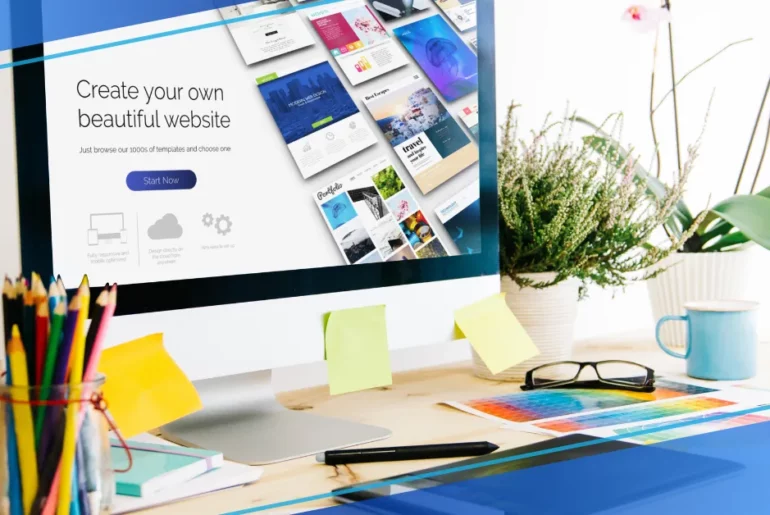We live in an information-rich age. One in which consumers never make a purchase decision without basic research into the product, price, quality, and consumer reviews, among others. No prizes for guessing how the research is carried out. In 2021, there is only one valid answer – the internet.
If your business is not yet on the internet, or your website is not very effective, you’re missing out on a great opportunity. Discover how simple it really is to get noticed by a potential customer.
Web development is necessary and is easier than you thought
Certainly, every small business needs a web presence today. It enhances the image and credibility of the company and dramatically expands its target universe. Further, the web offers an incredibly cost-effective medium to get marketing messages out. (But, that’s a discussion for another day).
The first steps towards the development of an online presence for your business
Choose a website name and get it registered (technically, this is your domain name or your company’s online address).
A good domain name should indicate the nature of your business AND must be easy to read/speak and remember. Make sure it uses one of the more popular extensions – (dot)com, or (dot)org, (dot)net, (dot)in – for easier recall.
Simultaneously, identify a web-hosting company that will allow you to use your independent domain and book the required space on their servers. There are simple DIY options for web development.
You can hire one or more professionals for web development. Or, if you are tech-savvy, there are quite a few Do-It-Yourself (DIY) options, both for websites or Apps. Choose from among no-code and low-code platforms such as WordPress, Wix, Shopify, GoDaddy, Weebly, Webflow, to name a few.
These allow you to simply drag-and-drop text and visuals using standardized, pre-defined templates. Though there are limits to customization, these platforms provide simple, cost-effective solutions for small businesses.
Key aspects of web development – design, content, visuals
Here’s a simple guide to key elements that you will need to pay attention to at the outset:
- Define the Focus: For this, you need to assess your consumers’ needs and mindset. What sort of interactive platform are you aiming to build? Is it for strengthening brand image and recall? To provide information? Or will you actually use it for e-commerce?
- Site map: Prepare a list of things you would need to include and try and group them under broad headings. Ideally, the site should have just five or six sections. In addition to the products and/ or services that you offer, other must-haves include About Us and Contact details. Your USP, your client base, and your credentials (through client testimonials, where feasible) are other key areas to look at.
- Content: Now, for each section and subsection, compile the information about your products and services that you intend to display. Depending on the nature of your business, you could also cover history, including earlier generations, positive feedback, some memorable achievements, awards, special recognitions, and so much more. Hire a content writer who can present the information creatively with bold messaging. Do ensure that every claim is believable and rooted in reality.
- Design: A clean and neat look with appropriate colors and matching fonts will go a long way in making your site attractive to the end-user. The ‘look and feel’ should match your brand personality and also appeal to the cultural sensibilities of your consumers.
Pay special attention to the Home/Landing page, for this is the make-or-break moment for most visitors to the site. The design and messaging should make them want to explore more.
A cluttered website distracts from things that matter – be they products or larger marketing messages.
- Visuals: An important and often neglected aspect is getting together appropriate images. Consider hiring a professional; a well-shot photo of a modern manufacturing set-up or of a retail space that is neat and easy to move around does wonders for your brand image.
An alternative is to use stock photos from websites like Unsplash, Pexels, Pixabay, etc., along with web design software like Adobe Dreamweaver, Adobe Photoshop, Gimp, or OpenElement to add stunning visuals to the site.
Make sure you use sharp images, but also optimize them for size and quick loading. A ‘slow-to-open’ page or one where images don’t display quickly can be a deal-breaker.
Make your website is user-friendly and see the business develop
Every structure needs to be easy to use and well maintained. A website is no different. Some things to take note of:
- Ease of Navigation: A good website should allow consumers to move easily across the pages – and virtually go from anywhere to anywhere else. A vertical or horizontal navigation bar that remains visible throughout is a good idea, with additional links also provided in the banner at the bottom.
- Simple fulfillment options: Make sure that consumers are able to easily access what they need with visible action buttons or links such as Compare, Like, Review or Rate, etc. A clickable Contact Us form that asks for basic details is also more user-friendly than providing an email address.
In an actual e-commerce enabled site, the path to selection, confirmation, and final payment should be made as visible and easy as possible.
- Monitor and Update: From the very outset, develop a plan for keeping your site relevant and do regular quality checks. Consider providing additional content to attract visitors through relevant blogs or other updates, BUT only if you are confident of being able to sustain them properly over time.
With these basic tips for web development, you can now build a website to help your business move ahead.





